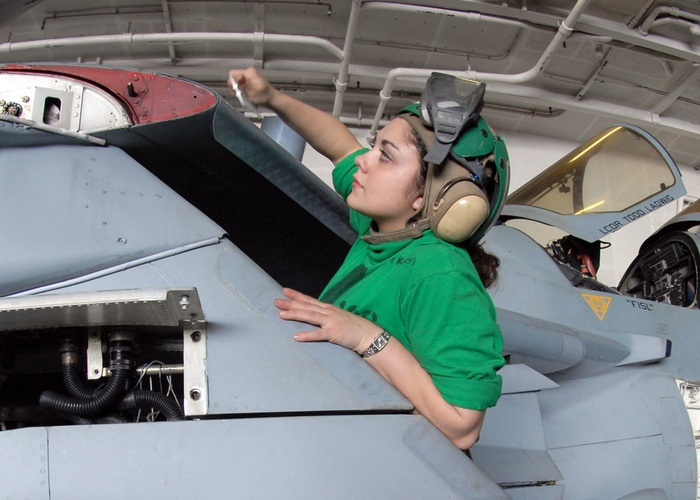The U.S. Air Force boasts a robust fleet of electronic warfare, surveillance, and reconnaissance aircraft. From the venerable RC-135 fleet to the infamous E-3 AWACS, to the E-8 JSTARS, and even the huge Boeing 747-200 E-4, ISR aircraft have been a core part of national security for decades. But if you look at this fleet, the base airframes are getting old. The E-3 and E-8 both use Boeing 707 airframes, an aircraft that mainstream commercial air carriers last used decades ago. The RC-135 is a KC-135 derivative, and is also aging fast. And the B747-200? These airframes in the USAF inventory are from the mid-1970s.

Obviously, electronic technology has improved radically since all these aircraft took to the skies, and one of the greatest improvements is a radical reduction in the size of electronic components.
The Air Force is now looking to replace the E-8 JSTARS with a much smaller aircraft with a far simpler logistics trail: the Bombardier E-11A BACN. The Bombardier Global 6000 is a highly popular business jet that boasts a loiter time of 12 hours and an intercontinental range of 6,000 nm. The design was intended to go from New York to Tokyo without refueling, which makes it the perfect platform for Battlefield Airborne Communications Node (BACN) work.
We dive into BACN and the Bombardier Global 6000 in this article to bring you insights such as:
- What is BACN?
- Why is the Bombardier Global 6000 ideal for BACN?
- What makes other platforms less suitable for BACN?
- What does Greenwood Aerospace offer your program?
At Greenwood Aerospace, we provide over 41 years of experience in government procurement to keep your flight program running on time every time. Through our expert services, we assist defense contractors, government agencies, and all branches of the U.S. military to ensure national security and promote mission readiness, including:
- Aircraft Sustainment
- Fixed-wing Aircraft Acquisition & Support
- MIL-SPEC Packaging
- Military & Defense Contracting
Reach out today to see how our services can enhance your aerospace program.
Now, let’s take a closer look at BACN and the Bombardier Global 6000, and answer all your questions, such as:
What is ‘BACN’?
BACN is an acronym for Battlefield Airborne Communications Node. But what’s in a name? In its simplest form, this is “WiFi in the sky,” which is certainly one of the functions of the E-11. But that’s not all, not by a mile. The E-11’s real talent is taking dissimilar communications, or disparate systems, and connecting the two as a data link.
Apparently, the Air Force fleet fighters can talk to each other, but not necessarily the bomber fleet, and the Navy fighters can’t talk to the Air Force, and so on. But the E-11 not only acts as a repeater to extend the operational communications range, it connects communications systems that otherwise cannot ‘talk’ to one another.
A Brief History of BACN
In order to promote intercommunications between aircraft during action, Air Force Materiel Command’s Electronic Systems Center along with Air Force Command and Control Integration Center (ACC) developed BACN. The initial focus of BACN was to enhance aircraft interoperability through four tenets:
- Supportable communications protocols across multiple systems
- Platform agnostic capabilities to mount on various aircraft
- Enhanced intelligence functions capable of sensing waveform characteristics during cross communication
- Untethered radio repeater systems to better move within any given battlespace
The first test flight for BACN took place on November 16, 2005, with the U.S. Air Force and NASA combining efforts to ensure its success. Due to its development in San Diego, BACN testing was conducted at Marine Corps Air Station Miramar.
While the first test flight for BACN was conducted using a World War II-era WB-57, advancements have proven the Bombardier Global 6000 ideal for BACN operations. So, what makes this aircraft the primary choice for BACN? We explore the major and potential BACN platforms, including:
- Bombardier Global 6000
- Gulfstream V (C-37)
- EQ-4B Global Hawk
- E-8 JSTARS
Let’s take a look at the premier BACN platform: the Bombardier Global 6000.
Platforming BACN: Why the Bombardier Global 6000?
The Bombardier Global 6000 is a natural platform for the BACN mission. The mission is not all that complex compared to other tactical missions, as it primarily requires the aircraft to fly to a high flight level (the Global 6000 has a ceiling of 51,000’) and fly a racetrack pattern for many hours. But the Global 6000 is perfect for this. For one thing, the 12-hour loiter time does away with the need for aerial refueling. It is also a much more efficient overall airframe than the E-8 JSTAR it is replacing, which is still churning away with four JT8D engines.

Also, the Global 6000 has an established parts and supply train. Also, the program is an interesting approach to manning the aircraft. The E-11 program uses contract maintainers rather than active-duty Airmen, and all of the pilots are volunteers who have come over on temporary status from other airframes. And the Air Force isn’t picky; they have pilots from all forms of fixed-wing aircraft, from fighters and bombers to mobility and tankers. From the pilot's perspective, it’s a great deal: you get to earn an invaluable type rating in a common business aircraft and build many hours in it.
For the Air Force, any opportunity to field an airframe without tagging on an entire infrastructure of an active duty maintenance package is an enormous saving.
Why Not Go With the Gulfstream V (C-37) Instead?
It makes sense to use the same aircraft already in the fleet, seeing as a handful of Gulfstream Vs in the fleet work as VIP transport aircraft. And, in fact, in several other countries, the G-V or a similar version of electronic warfare aircraft do engage in similar operations. But that isn’t how government procurement works in the U.S. military. Each new mission proposed is viewed on its own terms, regardless of the aircraft in the fleet. So, the proposal that won out for the BACN was the Bombardier Global 6000, and it has performed extremely well in a harsh and unfriendly environment.
Are There Any Other BACN Aircraft in the Fleet?
There are, and there were. These aircraft include(d):
- WB-57
- E-11
- EQ-4B Global Hawk
The first aircraft to operate BACN equipment and missions were actually on loan from NASA in the form of their WB-57s. However, with only two aircraft in existence, this was not a long-term strategy. But the mission demands an aircraft that can orbit extremely high for a long time; the WB-57, with its custom wings, could cruise in orbit at FL550. While the E-11 can’t quite get that high, it isn’t far off at FL510.
Why Not Use EQ-4 For Every Mission?
The EQ-4B Global Hawks, which were used for BACN missions, have been either retired or retrofitted for other missions. At the end of the day, there were no cost-savings advantages to operating UAVs over manned aircraft. Still, there are substantial advantages to flying manned aircraft that UAVs will never replicate. So, the Bombardier Global 6000 has the nod as the sole BACN aircraft in the fleet, which means it will be in high demand for the foreseeable future.

The Future of BACN: Replacing the JSTARS
One of the E-11 program's most important feats is replacing the much larger E-8 JSTARS. Right now, the first four aircraft retirements of the JSTARS program should have already commenced, with them being retired in FY22. One of the major detractors of the JSTARS program is the issues common to an aging airframe. One example is an aircraft that was in depot-level maintenance for over three years. This is particularly troublesome when you realize there are only 16 total aircraft in the fleet. Parts get a lot harder to source with these airframes that have been out of service and circulation for not just years but decades.

Also, it costs more to keep what amounts to a unique airframe (Boeing 707), instead of a common, smaller, cheaper airframe. Commercially-available off-the-shelf aircraft like the Bombardier Global 6000, Gulfstream V, or even Beechcraft King Airs are a cost-efficient alternative. And, as we said earlier, the overall costs of maintaining smaller, off-the-shelf twin-engine business jets are far lower than the costs of operating a heavy jet. There is simply no way around it.
When you can cram the capacity of the E-8 into a jet that is half the size, you will save money. And you will save millions in maintenance by using new airframes over labor and parts-intensive aircraft that were phased out of commercial use decades ago.
The Greenwood Aerospace Advantage
While new aircraft are low maintenance, they are never no-maintenance. The Global 6000 has “A” Checks every 750 hours and C Checks every 30 months, and they will require parts at those intervals. Those 750 increments go by quickly when only four aircraft are in the fleet, and they are flying long sorties almost daily. You must be sure that you can sustain your operation with a reliable supply of the right parts when you need them.
A core tenet of Greenwood Aerospace is the quick procurement of parts. We can procure whatever your fleet needs, whether you work on aircraft such as:
And not only will we find the parts, but we can store them for you and issue them whenever you need them. We also specialize in kitting parts for you. Say you have a list of parts, and they are from a bunch of suppliers. Well, instead of you waiting for them to trickle in, we procure the parts from the vendors, then package them in a consolidated kit instead, and then ship them to you. Whatever your fleet is, whatever your needs are, Government Procurement, operated by Greenwood Aerospace, is your one-stop shop for parts procurement! Give us a call; we’d love to discuss our services with you!
Employ Expert Services for Your Flight Program Through Greenwood Aerospace
Ready to get your flight program in the air with expert services? Contact Greenwood Aerospace today, and take advantage of our more than 40 years of experience providing all sectors of the aerospace industry with assistance through:
- Government Contracting
- Aircraft Leasing
- Aerospace Supply Chain & Logistics
- GPIQ Part Procurement Intelligence
- and More!
Our experts are ready and willing to fill all your government procurement needs. Request a quote, and we’ll respond with all the information you need within one business day! Have a large list of parts you need quoted? Email us at sales@governmentprocurement.com, and we’ll get started fulfilling your order quickly!
Interested in expanding your operations through one of the most trusted names in aerospace? Become a supplier to Greenwood Aerospace!
No matter your contracting or aviation needs, our team of experts looks forward to assisting your flight program!
Want to read more articles like this one? Check out these News stories next:


.svg)


.png)


